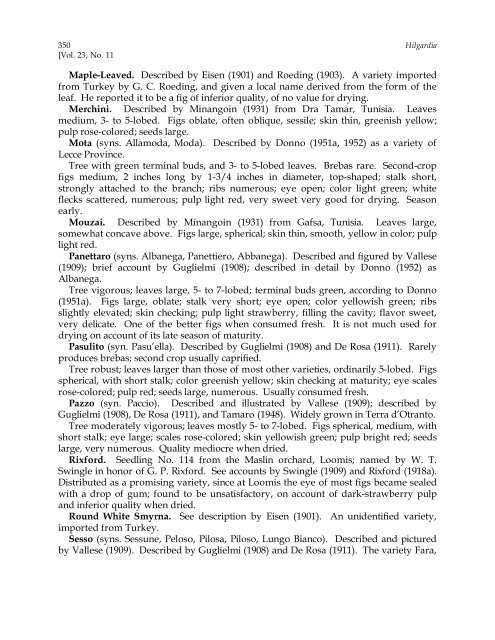Fig Varieties: A Monograph - uri=ucce.ucdavis
Fig Varieties: A Monograph - uri=ucce.ucdavis
Fig Varieties: A Monograph - uri=ucce.ucdavis
You also want an ePaper? Increase the reach of your titles
YUMPU automatically turns print PDFs into web optimized ePapers that Google loves.
350 Hilgardia<br />
[Vol. 23, No. 11<br />
Maple-Leaved. Described by Eisen (1901) and Roeding (1903). A variety imported<br />
from Turkey by G. C. Roeding, and given a local name derived from the form of the<br />
leaf. He reported it to be a fig of inferior quality, of no value for drying.<br />
Merchini. Described by Minangoin (1931) from Dra Tamar, Tunisia. Leaves<br />
medium, 3- to 5-lobed. <strong>Fig</strong>s oblate, often oblique, sessile; skin thin, greenish yellow;<br />
pulp rose-colored; seeds large.<br />
Mota (syns. Allamoda, Moda). Described by Donno (1951a, 1952) as a variety of<br />
Lecce Province.<br />
Tree with green terminal buds, and 3- to 5-lobed leaves. Brebas rare. Second-crop<br />
figs medium, 2 inches long by 1-3/4 inches in diameter, top-shaped; stalk short,<br />
strongly attached to the branch; ribs numerous; eye open; color light green; white<br />
flecks scattered, numerous; pulp light red, very sweet very good for drying. Season<br />
early.<br />
Mouzai. Described by Minangoin (1931) from Gafsa, Tunisia. Leaves large,<br />
somewhat concave above. <strong>Fig</strong>s large, spherical; skin thin, smooth, yellow in color; pulp<br />
light red.<br />
Panettaro (syns. Albanega, Panettiero, Abbanega). Described and figured by Vallese<br />
(1909); brief account by Guglielmi (1908); described in detail by Donno (1952) as<br />
Albanega.<br />
Tree vigorous; leaves large, 5- to 7-lobed; terminal buds green, according to Donno<br />
(1951a). <strong>Fig</strong>s large, oblate; stalk very short; eye open; color yellowish green; ribs<br />
slightly elevated; skin checking; pulp light strawberry, filling the cavity; flavor sweet,<br />
very delicate. One of the better figs when consumed fresh. It is not much used for<br />
drying on account of its late season of maturity.<br />
Pasulito (syn. Pasu’ella). Described by Guglielmi (1908) and De Rosa (1911). Rarely<br />
produces brebas; second crop usually caprified.<br />
Tree robust; leaves larger than those of most other varieties, ordinarily 5-lobed. <strong>Fig</strong>s<br />
spherical, with short stalk; color greenish yellow; skin checking at maturity; eye scales<br />
rose-colored; pulp red; seeds large, numerous. Usually consumed fresh.<br />
Pazzo (syn. Paccio). Described and illustrated by Vallese (1909); described by<br />
Guglielmi (1908), De Rosa (1911), and Tamaro (1948). Widely grown in Terra d’Otranto.<br />
Tree moderately vigorous; leaves mostly 5- to 7-lobed. <strong>Fig</strong>s spherical, medium, with<br />
short stalk; eye large; scales rose-colored; skin yellowish green; pulp bright red; seeds<br />
large, very numerous. Quality mediocre when dried.<br />
Rixford. Seedling No. 114 from the Maslin orchard, Loomis; named by W. T.<br />
Swingle in honor of G. P. Rixford. See accounts by Swingle (1909) and Rixford (1918a).<br />
Distributed as a promising variety, since at Loomis the eye of most figs became sealed<br />
with a drop of gum; found to be unsatisfactory, on account of dark-strawberry pulp<br />
and inferior quality when dried.<br />
Round White Smyrna. See description by Eisen (1901). An unidentified variety,<br />
imported from Turkey.<br />
Sesso (syns. Sessune, Peloso, Pilosa, Piloso, Lungo Bianco). Described and pictured<br />
by Vallese (1909). Described by Guglielmi (1908) and De Rosa (1911). The variety Fara,
















![Fig Trees in North Carolina [Archive] - IDigMyGarden ... - Figs 4 Fun](https://img.yumpu.com/26905320/1/190x245/fig-trees-in-north-carolina-archive-idigmygarden-figs-4-fun.jpg?quality=85)